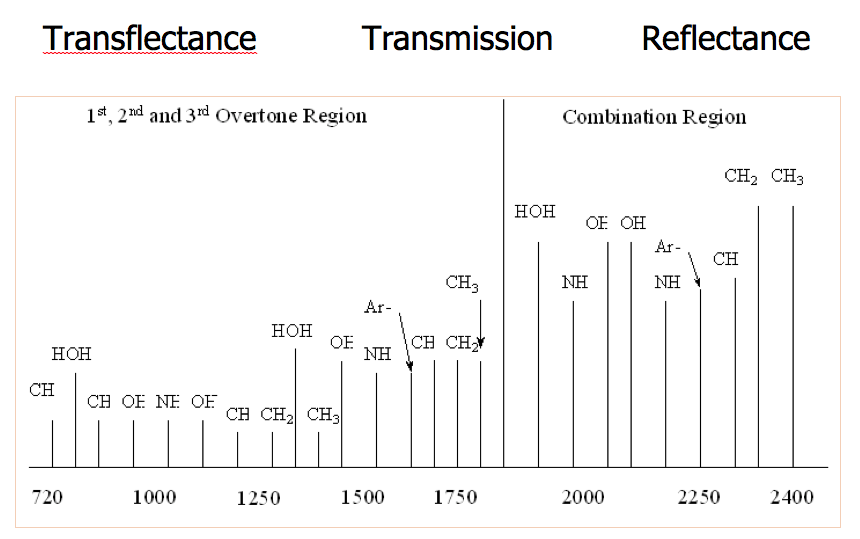Near Infrared Transmission Spectroscopy in the Food Industry
Introduction:
Near Infrared Spectroscopy is used in many industries including the pharmaceutical, petrochemical, agriculture, cosmetics, chemical and food industries. However in the food industry NIR has an almost universal application. Since food is made mostly from proteins, carbohydrates, fats and water, i.e. >99% by weight, NIR provides a means of measuring these components in almost any food.
NIR Analysis: Simple theory.
Figure 1. shows part of the electromagnetic radiation spectrum from 300nm to 10000nm. It shows the Visible, NIR and Mid IR spectral regions. When light energy interacts with a material, energy is absorbed at resonant frequencies associated with the atomic and molecular interactions of the material. In the Visible region, energy is absorbed when electrons jump from a lower to a higher energy state or orbit. In this region, chromaphores such as metal chelates, absorb visible light. Likewise Atomic Absorption Spectroscopy also uses this phenomenon to measure metals species as they burn in a flame.

Three NIR Regions
Figure 2. shows the NIR region from 720 to 2500nm. There are three parts of the NIR spectral region, 1) Reflectance, 2) Transmission and 3) Transflectance.

- Transflectance: 720 to 1100nm. This section is most suited to transflectance through a thick sample, such as, seeds, slurries, liquids and pastes. The absorption bands are due to 3rd overtones of the fundamental stretch bonds in the Mid IR region.
- Transmission: 1200 to 1850nm. This section can be used for transmission through liquids and films, as well as diffuse reflectance measurements off samples with high water contents. The absorption bands are due to the 1st and 2nd overtones of the fundamental stretch bonds in the Mid IR region
- Reflectance: 1850 to 2500nm. This section is predominantly used for making diffuse reflectance measurements off ground or solid materials. The absorption bands are due to combination bands, i.e., C-H stretch and bend combination bands.
The Transflectance region is of particular interest in the analysis of foods because it is suitable for measuring high moisture and high fat content products including meat, dairy products, jams and conserves, dough and batters. The major advantage of working in this region is that longer pathlength sample cells can be used to collect the NIT spectra. Typically a 10-20 mm pathlength can be used. This makes sampling easier and allows viscous and non-homogeneous samples to be scanned without further sample processing.
A major advantage of measuring in Transflectance as compared with Reflectance is that the spectra represent the variation in components throughout the entire sample, not just the surface. In reflectance, the first 1mm contributes as much as 99% of the spectrum. As such uneven distribution of components in the sample, egg, drying at the surface, or separation of a water or oil layer at a glass window, results in reflectance spectra that do not represent the entire sample.
Spectral Collection Modes
Transflectance:
The Transflectance region was first suggested by Norris as a means of measuring whole cereal grains and oil seeds because the NIR light could penetrate through the grains and oil seeds. Actually the Transflectance mechanism is a combination of reflectance and transmission, as the NIR light reflects off the surface of the seeds as it transmits through the sample to the other side.
Next Instruments
Next Instruments manufactures a range of innovative analytical and process instruments for the food, agriculture, human nutrition and medical researchindustries.
Contact Us
Come and see us at...Upcoming Field Days:
- Agritechnica, Nov 12-18th 2-023 Hanover, Germany, Hall 8, K10

